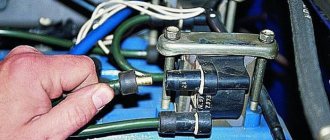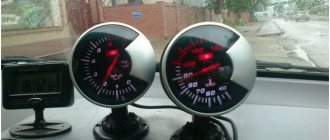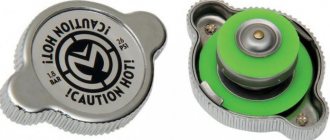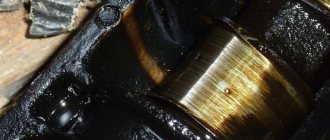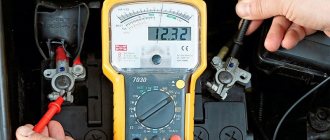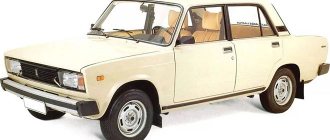High engine oil pressure: causes
The operation of any modern vehicle can be completely identified with the vital activity of the human body.
Each mechanism of this rather complex technological device is assigned certain functions. Oil plays the role of the life-giving fluid of the human circulatory system in a car. Without it, the power unit will not be able to perform its duties. In the absence of lubrication, the moving parts of the motor will instantly fail, destroyed by the force of friction.
Any sane person who cares about their health should monitor fluctuations in blood pressure. Like him, an attentive owner, striving to keep the car in working condition for as long as possible, carefully monitors similar indicators in the lubrication system of the power plant.
Failure to timely detect deviations from the standards laid down by the manufacturer during the manufacture of each specific engine can lead to unpredictable consequences, including the need for unplanned overhauls.
The pressure in the lubrication system can be either too low or too high. Is it possible to foresee the reasons causing such a malfunction of the power unit? If deviations are detected, is it worth urgently looking for the nearest workshop or is it better to do it yourself and fix the problem yourself? Let's try to figure it out!
Low oil pressure in a diesel engine: main reasons
Let's start with the fact that a diesel engine is somewhat different from a gasoline engine in the method of igniting the fuel-air mixture.
The fuel in such an engine ignites due to strong compression. For this reason, diesel is heavier than its gasoline counterparts; the parts of such an internal combustion engine are made of more durable materials.
It is quite obvious that such a motor (even taking into account the fact that it is less heat-loaded and not so resourceful) still experiences heavy loads during operation. This means that one of the most important indicators of the overall condition of the unit is the oil pressure in the diesel engine.
Moreover, if the pressure in the diesel lubrication system has dropped, then such a malfunction will quickly disable the power unit. First of all, a decrease in pressure will be indicated by the fact that the oil pressure lamp is on when the diesel engine is idling and/or under load. The appearance of extraneous sounds may also be noted; the unit operates more “hard” and noisily.
So, let's return to the reasons why oil pressure in a diesel engine decreases.
- Let us immediately note that quite often the lubricant pressure drops due to the fact that the oil level is low. To check, it is necessary to correctly measure the oil level, taking into account the peculiarities of measurement on a cold or hot internal combustion engine. The machine must be placed on a flat horizontal platform, and then the oil dipstick must be removed.
If the level drops below o, then the oil must be added. It should be remembered that it is highly not recommended to mix oils from different manufacturers, as well as those that differ in their properties. If after topping up the emergency lamp goes out, then everything is normal.
It is also worth inspecting the engine and engine compartment, and looking under the car. If obvious leaks are noticeable through seals, gaskets and other seals, the problem must be addressed immediately.
- The second point to pay attention to is the decrease in pressure due to too much resistance in the oil filter.
This can happen if the wrong model of the filter itself is used, the product is defective, or the pressure reducing valve in the filter breaks down. It is advisable to immediately replace the oil filter with a known good one.
- The next reason is severe dilution of the engine oil or significant loss of lubricant properties. It is often most appropriate to talk about antifreeze getting into the lubrication system, as well as the accumulation of a large amount of fuel in the oil.
As a rule, if liquid from the cooling system ends up in the oil system, the problem is the cylinder head gasket. It is also possible that cracks may appear in the block or cylinder head. Often the oil level in this case increases, while the coolant level in the expansion tank is reduced. Also, emulsion is visible under the oil filler cap, the engine begins to smoke white smoke, etc.
Fuel ingress often occurs when the mixture does not burn in the engine. As a rule, in this situation, the engine stalls, that is, one or more cylinders do not work, and part of the fuel flows through the piston rings into the crankcase. The injectors may also become leaky and leak diesel fuel even after the engine is stopped.
- Next you need to check the oil pump. A significant decrease in its performance or breakdown leads to low or no pressure in the oil system. Usually the oil pump can become dirty, but the possibility of its failure should not be ruled out.
It is also necessary to check the oil pump pressure reducing valve and the oil receiver mesh, which becomes clogged with deposits, as a result of which the oil pump is not able to create the required pressure and pump lubricant into the engine in full. One way or another, you will need to remove the oil pan in order to accurately determine the cause and efficiently eliminate it.
Purpose of motor oil
Some ignorant car enthusiasts mistakenly believe that lubrication is necessary for the engine only to prevent premature wear of rubbing parts. Of course, the formation of a special protective film that reliably envelops the moving elements of the power unit is the main purpose of motor oil. However, its functions are much more advanced:
- During engine operation, excess heat is generated in the cylinders. Motor lubricant does an excellent job of removing it;
- with the help of special additives, the oil helps cleanse the power unit from various deposits;
- The combustion process of fuel is usually accompanied by the formation of excessive amounts of oxides. A lubricating substance is used to neutralize them;
- Also, the purpose of motor oil is to prevent corrosion on the functional elements of the engine.
Oil plays a fairly significant role in ensuring the normal operation of the power unit. Just as a person cannot exist without sufficient blood, a motor cannot function without lubrication. Therefore, it is so important to pay due attention to timely oil changes, as well as monitor its pressure indicators.
Briefly about the design of the lubrication system
Continuing to draw parallels between the operation of the engine and the circulatory system of the human body, let’s consider what makes the oil circulate through the channels of the power unit, performing its assigned functions.
The role of the heart, which drives the life-giving fluid, in the engine is played by an oil pump. From it, lubricant is distributed through the “vessels”, which are represented by special channels in the car’s power plant, to all corners of the system.
Most modern passenger cars use a combined oil supply method. Under a certain pressure, the lubricating substance is pumped from the crankcase into the main line, bypassing the receiver and filter device.
The purified oil reaches all functionally significant parts and components of the engine, such as crankshaft bearings and camshaft bearings or piston pins. The slightest deviations in the normal operation of the system are regulated by special valves:
- reducing is designed to control pressure. Excessive excess of the standard value leads to valve activation. Through it, excess oil is discharged to the inlet;
- If the oil filter is clogged, the bypass valve is activated. His responsibilities include supplying unclean lubricant to the system.
A special sensor is placed on the cylinder block. Its functions include timely notification of the driver about an excessive drop in oil pressure in the lubrication system of the power unit.
Engine oil pressure. Which should it be? We will also analyze the 16 valve engine from the VAZ 2112
Nowadays, fewer and fewer cars are equipped with an engine oil pressure sensor, if you look at budget foreign cars - I don’t even remember which ones have it. However, now there are enough cars of previous generations on the market, but they had such a sensor. For example, on some VAZ, UAZ, VOLGA, etc. Many people ask the question - what oil pressure should be in the engine, that is, what is the normal value and what is not? It is not always possible to find information specifically about your model, so this article will be useful to everyone...
You know, now manufacturers are simplifying the dashboard of cars more and more, for example, on mine (Chevrolet Aveo T300) there is no longer even an engine temperature sensor, I’m already silent about the oil pressure sensor. It turns out that the manufacturers want YOU to ruin your iron horse faster, because you cannot control all the necessary parameters, and accordingly, if you operate it incorrectly, you will quickly come running to them to repair it. All this can be attributed to a conspiracy by the manufacturers. Although now they say everywhere that cars have become more reliable, different materials are used, etc., but practice shows the opposite, three to five years and it’s better to change the car. Oh, there were times - there were cars, there was complete control over the engine.
Why do you need oil at all?
I often hear that oil is the lifeblood of the engine. This is not entirely true, of course, the comparison is very rough, but still, the engine will not function without oil (or it will, but not for a very long time).
Modern motor oils lubricate and protect all rubbing parts, and these are pistons (with their rings), shafts, bearings, etc. Let's just say that good oil extends the life of the engine by many thousands of kilometers.
BUT oil must flow through the system, just like blood itself through human vessels, if the oil is simply poured in a pan and does not go to the rubbing parts - IT IS USELESS!
What builds up oil pressure in the system?
Everything is simple here - there is a special oil pump that takes oil from the engine sump and pumps it through the system. It is usually installed in the engine sump and driven by special gears that the engine turns during operation.
Oil through many channels begins to be supplied to the right places under pressure, as I already wrote, this is the crankshaft and its bearings, the camshaft and its “bed”, pistons, and much more.
It is the pump that is responsible for the pressure; if the pump stops, the pressure indicator will drop to zero. THIS CANNOT BE ALLOWED! Because the engine will not be lubricated at all, which will lead to instant breakdown, especially at high speeds.
BUT often the oil pump does not stop, but simply begins to pump worse, this indicates its wear, which is why you need to know the oil pressure in the engine! To respond in time to the nearest oil pump failure.
Alarm indication
Of course, now in almost all cars there is an emergency indication for a complete lack of pressure, this is known to us all - a “burning oil can”. If it does not go out for some time after starting, for example 10 - 20 seconds is one thing, it is almost always the fault of the oil filter. But if the lamp is constantly on, then this is already an alarm bell. Perhaps the oil pressure sensor has simply failed, or perhaps the oil pump has failed.
In any case, the emergency indication is very important, and I do not advise you to joke with it; nevertheless, this is fraught with a major overhaul of the engine.
Remember this rule, if the lamp comes on, then turn off the car and preferably immediately to a service station, either a tow truck, or in tow.
How to check oil pressure?
The actual check is carried out using a special device - a pressure gauge. It is also worth noting that you need to warm up the engine to operating temperature, usually 90 degrees Celsius.
If you measure with a cold engine, especially in winter, the pressure can jump to high values, from 0.5 BAR or even higher, but measuring with a cold engine is WRONG!
In order to check the pressure, you need to find the emergency sensor, which is responsible for the indication on the dashboard. It is worth noting that it is not always located nearby and it is convenient to unscrew it. We unscrew it, and in its place we attach the test output connected to the pressure gauge.
How dangerous is excess engine oil pressure?
Every more or less experienced driver always scrupulously notes deviations from the standard performance indicators of the engine, laid down by the manufacturer during the manufacturing process of the car. This is akin to how a person controls his health. Any malfunction is identical to feeling unwell. What “diseases” of the power unit can be a sad consequence of high engine oil pressure in the engine?
It should be noted that the malfunction in question is not as dangerous for the normal operation of the car as an insufficient amount of lubricant.
The most predictable consequences are:
- First of all, excess oil pressure negatively affects the integrity of the sealing surfaces. The seals, unable to withstand excessive load, collapse, releasing excess oil from the system. Increased lubricant consumption;
- As oil pressure increases, its quantity increases. Excess oil is released through the crankcase ventilation system. This also affects the increase in consumption;
- engine malfunctions occur as a result of lubricant getting on the surface of the idle speed regulator;
- Damage to the air flow sensor, even complete failure, is possible from contact with the oily substance of the measuring element of this device. A similar problem is typical for power units with a fuel injection system;
- The increased level of lubrication generated by excess pressure leads to foaming of the oil by the crankshaft counterweights. An oil emulsion saturated with gases harms the normal functioning of the engine. Knocking may occur in valve actuators and hydraulic compensators;
- The most unpleasant consequence of excess pressure in the lubrication system of a power plant is the destruction of the piston skirts.
Of course, the listed factors are not critical for normal operation of the motor. However, dumping excess lubricant causes a decrease in the level of oil product, and an insufficient amount of oil in the system is fraught with much more tangible troubles.
How to check the serviceability of a part
After starting the internal combustion engine, the oil pump pumps fluid to all engine systems. From the crankcase through the filter, oil is supplied to each part, and the pressure gradually rises to operating condition. The light on the instrument panel lights up when there is insufficient pressure in the system. If the indicator does not go out longer than usual, then it is worth checking whether the sensor is working properly.
But a long-burning light can also indicate problems with low pressure due to other parts:
- The oil filter is clogged with dirt. The liquid entering the system is insufficient. The pump cannot create the required pressure. In this case, it is worth cleaning the filter and replacing it with a new one.
- Carbon deposits, which are washed away by oil from inside the engine, can also accumulate on the oil pan, clogging the oil receiver mesh and reducing its permeability. It is better to drain the lubricating fluid from the crankcase. If contamination is severe, replace with new oil.
- Oil pump malfunction.
- High wear of engine parts, in particular the crankshaft.
- Poor quality oil is poured - it is worth buying proven brands recommended by the car manufacturer (semi-synthetic 10W-40, volume - 3.5 l).
- Insufficient fluid level in the system - checked when the engine is cold with a dipstick, solved by adding oil.
If these reasons are considered, and the lamp on the panel is on, then the problem is a malfunction of the DADM (emergency oil pressure sensor) or the wiring from the device to the indicator. To check the device, you need to know where the faulty oil pressure sensor is located on the VAZ 2114. The part is located under the decorative cover of the internal combustion engine (internal combustion engine) on the left side of the engine compartment. The device is installed near the timing belt (gas distribution mechanism), on the right in the cylinder head (cylinder head), below the valve cover.
To professionally check the performance of the emergency oil pressure sensor, it is recommended to take the car to a specialized service station. But this is not always possible. Therefore, you need to know how to check the oil pressure sensor yourself. There are several options here:
- Visual inspection of the part - smudges in the place where the device is fixed may indicate a problem with the sealing washer. It is necessary to replace the ring and wipe the installation site. The fastener also leaks in the event of a malfunction of the excess pressure relief valve in the oil pump (the pressure in the system is above 0.8 atmospheres). If signs of a leak are found at the terminal attachment point, this clearly indicates the need to replace the sensor itself.
- The sensor is unscrewed and a pressure gauge is installed in its place. It is necessary to start the car engine and monitor the readings at idle speed. At normal oil pressure in the system, the parameter will be within 0.65 atmospheres. This indicates a faulty part.
- Without starting the internal combustion engine, with the sensor removed, it is necessary to crank the starter. Splashes from the device mounting hole indicate the presence of pressure in the system. But in this way it is impossible to find out its parameters.
- A new sensor is installed in place of the old device. If it works correctly, then the old device is faulty.
The oil pressure sensor on the VAZ 2114 cannot be repaired. But the low cost of the part will allow you to simply replace it with a new product.
In any case, if the pressure in the oil system is low or completely absent, it is not recommended to drive the car any further. This could lead to a serious problem with the engine.
Prerequisites for high blood pressure
As in the human body, any deviations from standard indicators in the power unit are caused by very specific reasons. The following factors usually lead to excess pressure in the oil system:
- One of the most common reasons is the use of a lubricant of the wrong viscosity. Oil that is too thick has great difficulty circulating through the channels. This reason becomes especially relevant in winter if the engine continues to use summer oil products;
- The malfunction in question can be explained by obstruction of oil pipes and filters. This problem is caused by clogging of these parts with oxidation products and other foreign deposits;
- An increase in pressure in the system is caused by a violation of the free circulation of lubricant, which occurs due to defects in the pressure reducing valve. The damaged part does not perform its intended function. Excessive amounts of petroleum product are not discharged to the inlet, remaining in the system;
- Violation of the normal operation of the bypass valve contributes to the formation of excess pressure. Through it, unrefined oil should be supplied to the power unit when the filter device is clogged;
- sometimes exceeding the standard value occurs due to excessive pressure in the crankcase. Typically, increased gas breakthrough leads to such consequences. In addition, crankcase pressure can reach unacceptably high levels due to a defective exhaust valve;
- and last on the list, but not least, is equipping the lubrication system with inappropriate parts. Each element must meet certain parameters. Just as during transplantation, a foreign body is rejected by the human body, so when replacing spare parts, the inappropriate fragment quickly fails.
As you can see, there are not so many reasons that influence an excessive increase in oil pressure in the power unit. A sufficiently experienced driver is quite capable of preventing their occurrence.
Reduced oil pressure in used diesel engines
For older diesel engines, the main reason for low oil pressure in the lubrication system is natural engine wear. In this case, the gaps between the parts increase too much, and the oil pump is no longer able to compensate for the consequences of such wear and create the required pressure.
As a rule, engine operation in this case is accompanied by knocking, metal shavings may be observed in the oil, etc. In such a situation, the oil pressure can be normalized only by repairing the internal combustion engine.
We also recommend reading the article on how to check and measure engine oil pressure. From this article you will learn what the pressure in the lubrication system should be, as well as what methods exist for measuring the oil pressure in the engine oil system.
- Let us also add that low lubricant pressure may be the result of using the wrong type of oil for a particular engine in terms of viscosity-temperature characteristics. Filling with a counterfeit (counterfeit) product, etc., leads to similar consequences.
It is also important to take into account that the use of flushes before changing the oil in some cases causes the deposits in the sump, peeled off from the walls, but undissolved, to clog the oil receiver mesh and narrow oil channels.
At the same time, you need to take into account the fact that the pressure in the oil system may be fine, and the lighting of the emergency warning light on the instrument panel is a consequence of a breakdown of the oil pressure sensor. For this reason, at the initial stage it is better to immediately determine what the oil pressure is in the diesel engine. This must be done using a special separate device, which is screwed in instead of the standard sensor.
Ways to combat excess pressure in the oil system
Each disease manifests itself with certain symptoms. In accordance with them, a special method of treating the disease is being developed.
Methods for dealing with high oil pressure in a power plant are selected based on the reasons for its occurrence:
- if the viscosity is inappropriate, a lubricant change will be required, taking into account the operating conditions of the unit, including temperature conditions;
- Elimination of blockages in oil-conducting channels and other elements of the system is carried out using special means available on the modern market in huge quantities. Lubricant filters also need to be cleaned or replaced periodically;
- Regular technical inspections contribute to the timely detection of faults in the system valves. Unsuitable or damaged parts must be replaced immediately. Moreover, each element must be selected individually, taking into account the design features of a particular power unit.
Preventing pressure fluctuations
Regular diagnostics of the condition of the diesel engine will help to avoid deviations from the norm in performance. The change in pressure force itself is a symptom of the manifestation of problems or serious breakdowns.
Timely change of the oil filter and careful attention to the choice of the oil product itself help maintain the correct pressure in the system. You should not skimp on the quality and quantity of lubricant; such inappropriate tightness can lead to more serious losses.
Increased pressure in the crankcase of a VAZ engine
- To the beginning of the forum
- Forum Rules
- Old design
- FAQ
- Search
- Users
Clean the mesh in the valve cover and that’s it.
Here I have another guess about the pipes leaking. In short, the pipe becomes rougher over time and begins to sweat. Tightening the clamp doesn't really help. (or not always) I drew conclusions for a reason. The pipes were also sweating, and I also tightened them. But when I changed them, the sweating stopped. So there you go.
If you disconnect the thick head/receiver pipe, the speed increases.
If the rings were stuck, the dynamics would be lost, but the car drives quite well.
Yaffet wrote: if the rings were stuck, the dynamics would be lost, but the car drives quite well.
Not at all necessary. Test the compression. Most likely the CPG is worn out.
This is the last thing I would like. Mileage only 85 thousand.
Yaffet wrote: If you disconnect the thick head/receiver pipe, the speed increases.
This means that the amount and pressure of crankcase gases has increased.
The pipes were also sweating, and I also tightened them. But when I changed them, the sweating stopped.
If only the pipes were sweating, I wouldn’t bother so much. The seals began to sweat, and this is already serious.
And the mesh: it is most likely clean, because... there is no oil in the pipes to the receiver and through (on which the pipe is put on) the “siphon” is quite noticeable, almost the same as through the plug.
And wear on the CPG: wouldn’t the spark plugs be sooted? To maintain the dynamics of the car, the mixture should be enriched, but there is no increased consumption, there is no soot on the spark plugs.
Source
Engine crankcase ventilation - what is it and why is it so important for the engine
Today we’ll talk about an important car system - crankcase ventilation of the engine.
. Some people call it the “lungs” of the motor, but to me it’s the anus. Why? – Because if you don’t take care of it, then the power unit, no matter how modern it is, will be bad. Comparable to bloating in a person, this problem can also be caused by the brain if it is not eliminated.
Let's figure out what it is and why it is so important for the car. What happens if you start it and don’t monitor its performance. I’ll tell you in detail what role the crankcase gas valve plays in the system.
What it is
During operation of an internal combustion engine, high pressure builds up in the chamber. Some of the exhaust gases “break through” in the gap between the piston and the cylinder wall. They get into the engine crankcase.
Many will object. The pistons have compression and oil rings that should prevent this. But gaps still exist. As the piston group wears, this distance increases. This is especially true for used cars.
In addition to the exhaust, gasoline vapors or the fuel itself can enter the crankcase if the fuel system or ignition fails. Crankcase ventilation serves to remove combustion products of the fuel-air mixture.
What problems may arise
- Gases mix with oil. It changes its physical properties. This will negatively affect the life of the motor;
- Excessive pressure is created inside the engine. This leads to “squeezing out” of gaskets and seals. Where there are weak spots in the seals, there will be oil leaks and oil fogging.
Often on older cars you can notice leaks through the crankshaft oil seal and valve cover gasket. In worst cases, pressure raises the dipstick.
Therefore, we must remove these gases from the crankcase. If your stomach is bloated, you feel like you're going to burst. So is the motor. He needs to “fart his way through”, excuse the expression. If it doesn’t do this, then you will spend money on repairs and constantly adding oil.
Design
In modern cars, the crankcase ventilation system has a more complex design. It consists:
Oil separator
Designed to separate oil vapors from gases. This is necessary so as not to clog the intake manifold and its elements with oil. Moreover, getting it into the cylinders during fuel combustion will not bring anything good; the quality of the fuel mixture is impaired, etc.
There are two types:
- Tangential or centrifugal type;
- Labyrinthine.
The first type has the shape of a cone or cylinder. It has two pipes at the top and one at the bottom. In the upper part of the oil separator, hoses from the engine crankcase are connected to one inlet fitting. The second outlet is the outlet; a hose is attached to it, which removes gases without oil vapors to the ventilation valve. The lower pipe drains the separated oil into the oil receiver (crankcase).
Crankcase gases enter the oil separator into the inlet pipe. In the housing, they are given a tangential movement; they are twisted in a spiral relative to the central axis of the separator. Due to centrifugal forces and the fact that oil is heavier than gas, the former settles on the walls of the device. Gases rise upward and move further through the system through the outlet fitting. The oil flows down, returning to the engine.
Crankcase ventilation valve
It is needed to control the supply of exhaust gases from the crankcase to the engine intake manifold. Since a large vacuum is formed there, a vacuum can be created in the engine crankcase through the pipe system. This means that even more gases will make their way into the crankcase. Plus, the probability of “sucking” fuel vapor into the crankcase increases significantly.
The valve, depending on the engine load, opens when the vacuum in the manifold is low and closes when it is high. The pressure in the crankcase increases, the valve opens slightly. Gases are “sucked” into the intake, reducing pressure. If a vacuum is created, the valve closes, stopping the suction of gases from the crankcase into the intake manifold. This regulates the flow of exhaust gases through the crankcase ventilation system and maintains a slight vacuum. For more details, watch the video:
What is the pressure in the engine cooling system
So, internal combustion engines are a heat engine, that is, the energy of fuel combustion is converted into mechanical work. At the same time, the efficiency of engines of this type (especially gasoline) is quite low, since useful energy is largely spent on heating and friction of associated parts.
When it comes to heating, the engine needs efficient cooling. If parts overheat, the gaps between them decrease as a result of thermal expansion. In the case when the power unit is very overheated, the motor simply jams.
To remove excess heat, modern internal combustion engines use a combined cooling system, which consists of air and liquid systems. The liquid system implements the circulation of a special coolant (antifreeze, antifreeze) through channels in the block and cylinder head.
The air system should be understood as a cooling system fan, which turns on at a certain temperature and cools the engine by blowing it with air flow. As for the liquid system, the coolant circulates in this system under a certain pressure.
It is noteworthy that the pressure inside the cooling system is not created intentionally (forced), but is the result of the operating features of this system. By the way, to maintain a normal temperature balance for the engine, it is not the pressure that is important, but the normal circulation of coolant through the system.
So, the coolant in the system heats up. Heating causes expansion and the liquid level in the system rises. Taking into account the fact that the liquid system is closed, it is not difficult to guess that as the internal combustion engine and the liquid itself heat up, the antifreeze/antifreeze expands greatly and increases in volume (up to 20%). As a result, pressure builds up inside.
Moreover, the tightness and pressure in the system allows the boiling point of the coolant to increase. In simple words, if at atmospheric pressure coolant or water boils at 100 degrees Celsius, then, taking into account the increased pressure, the boiling point shifts upward.
We also recommend reading the article about why the engine gets hot but the radiator is cold. From this article you will learn about the main reasons why the engine overheats, but the cooling radiator does not heat up.
For example, a pressure of 1.5 atmospheres means that the coolant will boil at 110 degrees, increasing the pressure by another 0.5 atm. will push the boiling point back another 10 degrees, etc. If we add that in modern antifreezes the additive package also makes it possible to improve the properties of the liquid itself, the boiling point is often around 130-140 degrees at the required pressure. This allows you to increase the temperature at which the thermostat operates, making the engines hotter, more productive and at the same time environmentally friendly.
Let's move on. On different engines, the operating pressure inside the cooling system may differ from 1.2 to 2.0 atm. or even more (in other words, from 1.2 to 2.0 Bar). This indicator depends on the design features of the internal combustion engine, the properties of the coolant itself, temperature control, etc. In this case, the pressure is created by the liquid itself when heated in a closed circuit.
In this case, excess pressure is released into the atmosphere by a special valve located in the cap of the expansion tank. Please note, it is important to understand that the performance and efficiency of engine cooling directly depends on this valve and the overall tightness of the system itself.
In simple words, if the system is sealed, the valve controls the pressure inside the system, preventing the formation of excess pressure, which prevents the rupture of pipes, the radiator or the expansion tank itself, etc.
Another function of the reservoir cap is to equalize pressure after the engine is turned off and the coolant begins to cool. The level of cooling coolant decreases; during cooling, a vacuum inevitably forms in a closed system. It is quite obvious that this will also lead to problems. To equalize the pressure, the valve in the expansion tank cap opens and outside air is drawn in through it.
How to check?
The first method is simple
– visual. If there are oil leaks or fogging at the oil seals, it’s time to check the crankcase ventilation system.
Second way
. Open the oil filler cap. We start the engine and place our palm on it. If you feel increased pressure with your hand, the system malfunctions. In sad cases, you can observe bluish smoke from the neck. If the ventilation valve is stuck in the open position, a hissing sound is heard or the palm is sucked in, that is, air is sucked through it into the engine crankcase. The same effect can be observed if you pull out the oil level dipstick.
How to Diagnose and Fix Engine Pressure Problems
Two problems can occur in the engine lubrication system. The pressure can deviate in two directions:
Signs and remedies for low engine pressure
The first rule: if while driving the engine pressure sensor light (watering can on the dashboard) comes on, you should stop immediately. Driving a car whose engine is starved of oil is simply dangerous. If the engine seizes, an accident may occur, for which the owner of the faulty vehicle is found to be at fault.
What to do if the engine oil pressure light comes on on the instrument panel:
- stop if the car is moving,
- Check the oil level after 5 - 10 minutes, when the oil has drained into the crankcase.
When the level is below the minimum level, the pump cannot capture enough oil. Add engine oil using the dipstick as a guide. Often this is enough for operating parameters to return to normal values.
Ingress of foreign substances
If the oil level, on the contrary, has increased, antifreeze or fuel has probably gotten into it. Check to see if the volume of the antifreeze has decreased and if you can smell fuel from the oil filler neck. If such signs are found, these systems will have to be repaired.
Problems with pressure reducing valve
If the oil level is fine, the causes of engine pressure problems should be looked for elsewhere. For example, due to contamination, the pressure relief valve is stuck in the open position or the oil receiver screen is clogged. To deal with this problem, it is necessary to use a special flush.
Unsuitable type of engine oil
Another reason for low engine pressure is insufficient viscosity of the engine oil at operating temperatures. In this case, the indicator on the dashboard begins to blink when the engine speed decreases to XX when the engine is warm. Make sure the crankcase contains the recommended grade of oil. There may have been an error during the last replacement.
Even suitable motor oil can lose its properties due to overheating or other unfavorable factors. This problem is “treated” by changing the engine oil. A temporary solution is to use a special viscosity stabilizer.
Malfunctions of the filter unit
If the engine oil pressure light comes on after starting the engine and does not go off for 10 seconds or a little longer, the problem is usually in the oil filter. Check and replace this element if necessary.
How to repair
In old domestic cars, the factory installed a so-called “breather” to solve the problem. It was direct-flow, constant action. You just had to monitor its frequency. Periodically disassemble the structure and wash it from oil deposits.
Modern cars have not come far in terms of system maintenance. It is necessary to periodically check its operation as described above. In case of problems or failures, we clean all elements. They are, in most cases, removable, can be washed with gasoline, dried and reinstalled.
Conclusion
This system is very important for the correct operation of the car engine. Its malfunction leads to damage to any sealing seals, rubber bands, and oil leakage. Therefore, it is necessary to monitor its performance. Moreover, “taking care” of her is not very difficult.
I would like to note that the operating principle and design of the crankcase ventilation system of atmospheric MPI engines differs from turbocharged ones. If you are interested, I will write a separate review on this topic. Write about it in the comments, I look forward to your feedback.
Source
